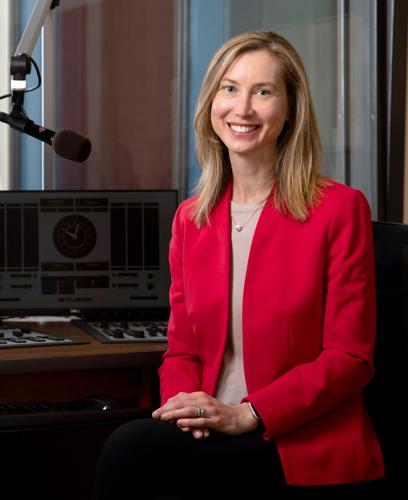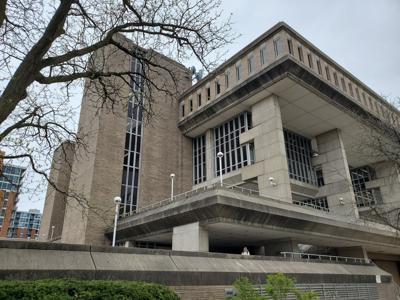Wisconsin Public Radio expects to lay off employees in the coming weeks, but the scope and timing of the cuts are unclear.
The organization is also likely to become more closely aligned with PBS Wisconsin.
An email WPR leaders sent to staff in March, which the Cap Times recently obtained, says the public radio network continues to face “a significant structural deficit” and has used reserve funds to balance its budget in recent months.
“Since we began our budget-focused conversations in the fall, we’ve talked about keeping layoffs in consideration as we find other savings and raise revenues. Now … we’re in a position to confirm that WPR will need to make staff reductions as we work toward a balanced budget,” WPR director Sarah Ashworth and Kealey Bultena, associate director, wrote in the email.
The message didn’t specify how many or which types of jobs could be affected. Asked about the layoffs last week, Ashworth said no decisions had been made.
“As a practice, we don’t and would not discuss personnel issues,” Ashworth told the Cap Times.
The number of listeners and members at WPR has declined in recent years, similar to national trends.
“While Wisconsin Public Radio’s revenue is strong, it has not kept pace with expenses,” Ashworth said. “We are currently working on next year’s budget. Service to the people of Wisconsin and the responsible stewardship of our public and private support are our highest priorities.”
WPR and PBS Wisconsin are part of the Division of Public Media at the University of Wisconsin-Madison. Leaders at Wisconsin Public Media plan to bring the two entities together under one organizational structure, according to another email obtained by the Cap Times that was sent to WPR staff in April.

Jordan Siegler serves as the interim executive director of the Division of Public Media at the University of Wisconsin-Madison. Calls from the Trump administration and Congress to defund the Corporation for Public Broadcasting "would have a profound impact on public media here in Wisconsin and across the nation,” Siegler said.
“We will maintain the PBS Wisconsin and WPR brands, which remain important for audience engagement. However, we will evolve our messaging to reflect greater collaboration and shared priorities,” Angie Rosas, Wisconsin Public Media’s chief of staff, wrote in the email.
The potential changes come as the Trump administration and Republican members of Congress weigh more than $1 billion in federal funding cuts for public media.
“There have been calls for defunding the Corporation for Public Broadcasting (CPB), the independent nonprofit steward of the federal government’s investment in public media. We take these threats seriously because defunding the CPB would have a profound impact on public media here in Wisconsin and across the nation,” Jordan Siegler, interim executive director of Wisconsin Public Media, said in a statement.
On Thursday, President Donald Trump issued an executive order calling for the Corporation for Public Broadcasting to end federal funding for NPR and PBS, which would also affect local stations. Generally, CPB grants account for about 10% of the budget for WPR and PBS Wisconsin.
Layoffs could come this summer
In a recent interview, Ashworth and Jon Miskowski, who leads PBS Wisconsin, declined to answer detailed questions about potential layoffs, saying they couldn’t discuss personnel issues.
The March email sent to WPR staff explained, “It is not enough to reduce our spending; we need to set WPR up to effectively serve audiences now and into the future.”
The layoffs are expected to happen in June, but the notices could be issued this month or in July, according to WPR leaders in the email.
“We know this news is uncomfortable,” the email says. “These decisions are not easy; we will need to end some valuable work and say goodbye to good colleagues.”

Sarah Ashworth, director of Wisconsin Public Radio, said no decisions had been made as of late April about potential layoffs at WPR.
The organization “must act now to put WPR on a path toward sustainability and one that also finds new ways to connect and have an impact on our state,” according to the email.
While WPR generally expects membership revenue to grow over the next couple years, the organization’s 2027 goal is roughly $413,000 below what the organization received last year, according to a recent budget request submitted to state lawmakers.
WPR is conducting its spring member drive through Tuesday. Listener support is WPR’s single largest source of funding. Member contributions, major gifts and bequests made up 42% of the organization’s funding from July 2023 through June 2024, said WPR spokesperson Jeffrey Potter.
PBS Wisconsin, meanwhile, has experienced a growth in members and expects the number to keep increasing in the coming years.
Organization continues to evolve to serve Wisconsin
Plans to bring WPR and PBS Wisconsin together under a “one team” structure are still in early stages, according to the April email sent to WPR staff.
“Several areas of (Wisconsin Public Media) are already combined,” the email says, including finance and human resources.
The first step will center around building a new leadership team. Although details are still being sorted out, the new structure “may include a blend of staffers focused on TV-specific or radio-specific work. However, work assignments that support activities for both the PBS Wisconsin and WPR brands may be most common,” according to the email.
Division leaders hope the move “can contribute to our financial sustainability while, most importantly, strengthening our service,” the message says.
There’s been a lot of reinvention and reorganization over the decades with how PBS Wisconsin and WPR collaborate, Miskowski said.

Jon Miskowski, director of PBS Wisconsin, said the television station and WPR have long worked together under the Division of Public Media at the University of Wisconsin-Madison. An April email sent to WPR staff suggests the two entities could come together under one organizational structure.
Last year, WPR created separate news and music stations to help listeners better find what they’re interested in.
Going forward, WPR and PBS Wisconsin are looking at how they can best work together to serve Wisconsinites across the state through audio, video and digital platforms, Ashworth said.
There are different models across the country. Ashworth came to WPR in 2023 from Vermont, where public radio and TV merged in recent years. While Vermont’s circumstances were different from Wisconsin’s, that move centered around a question of how to more effectively benefit people in the state, Ashworth said.
Amid the possible changes and layoffs happening locally, Wisconsin Public Media is hiring for multiple positions, including a marketing and communications director and public relations director, who will serve radio and TV.
‘Now is the time to speak up’ about public media
WPR and PBS Wisconsin are working “to meet audience members where they’re at today,” Ashworth said. Many people no longer differentiate between TV and radio, so the organizations are trying to reflect the reality of how people consume media, while providing education, music, cultural programming and high-quality journalism, she said.
With the added threat of losing federal funding, Ashworth and Miskowski encourage people to share their stories about how public media affects their lives. For instance, “the investment that this country makes in PBS KIDS is an enormous contribution to preparing children for school,” Miskowski said.
“It’s irreplaceable … and it is effective,” he said.
Ashworth added, “If you'd like to support continued investment in public media here in Wisconsin, now is the time to speak up.”
People can learn more at wpr.org/protect and pbswisconsin.org/protect.









